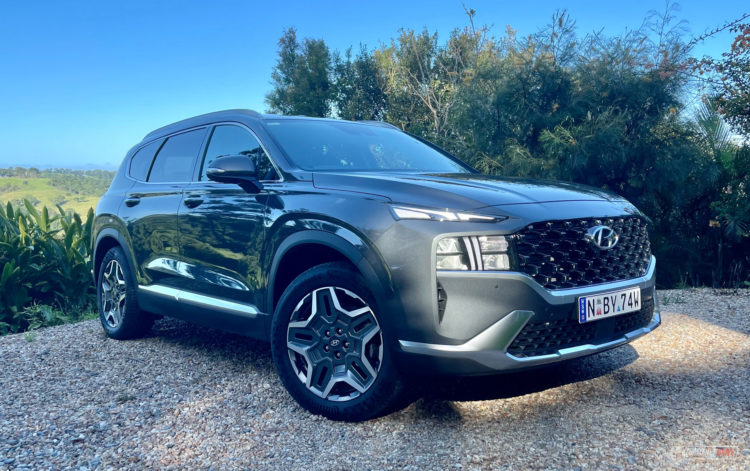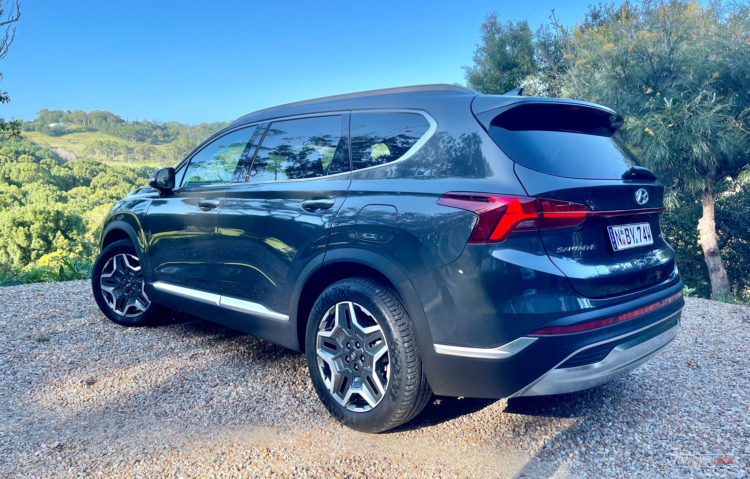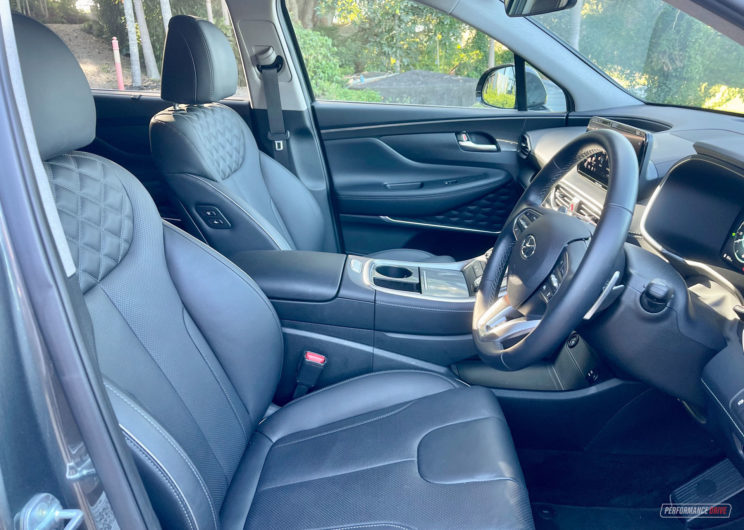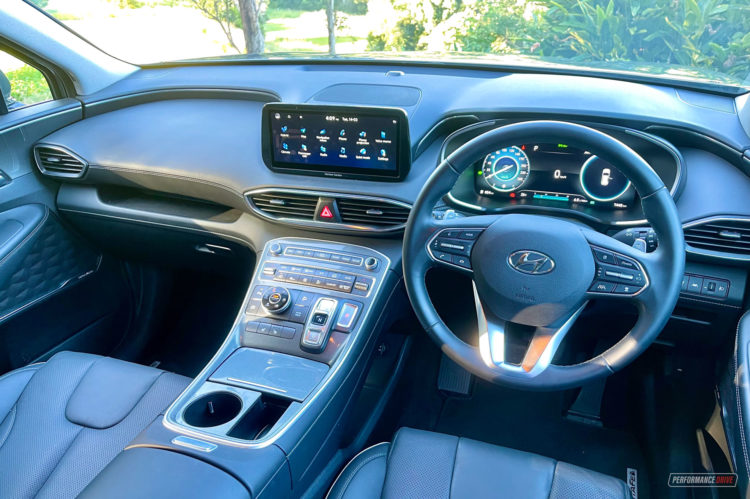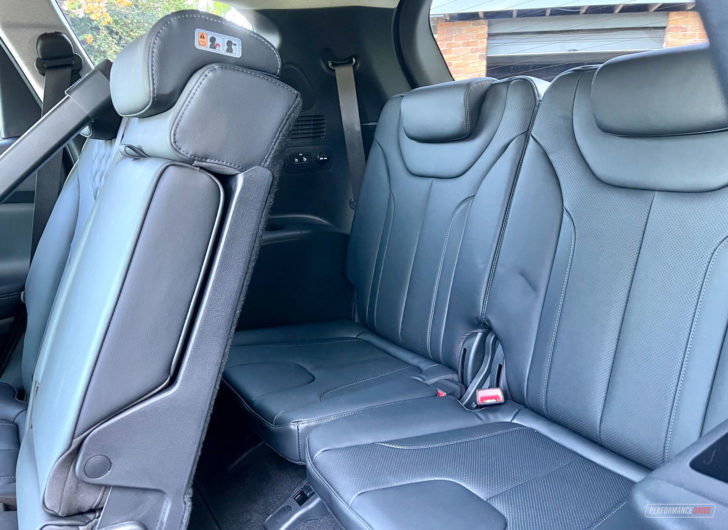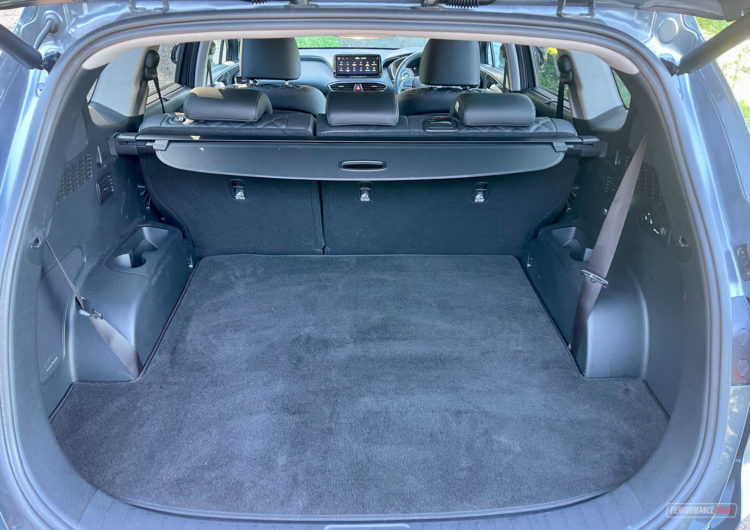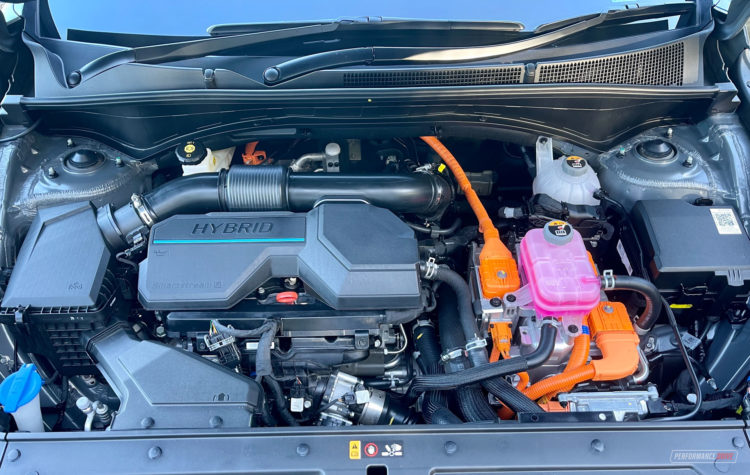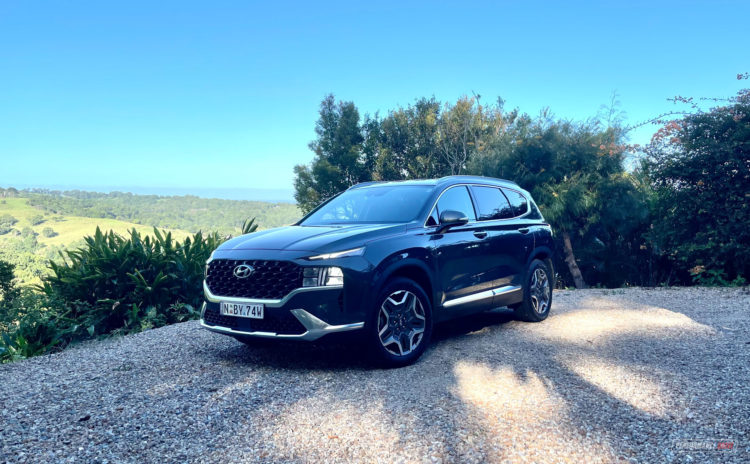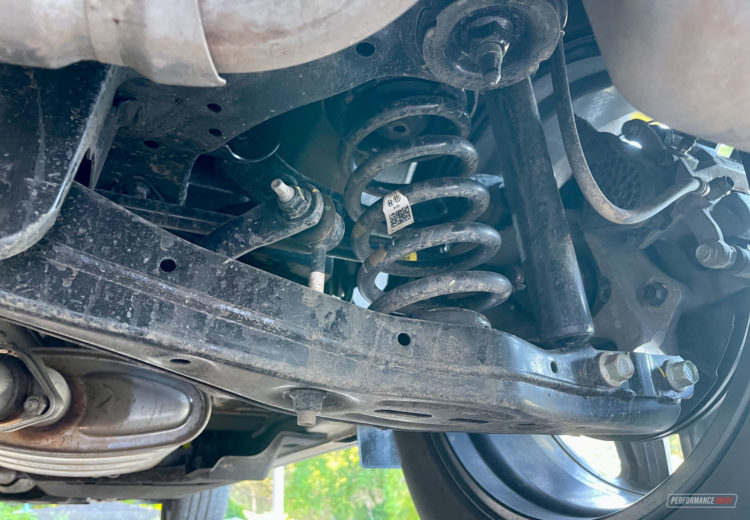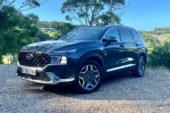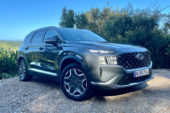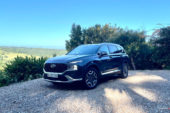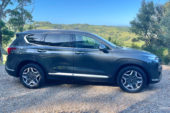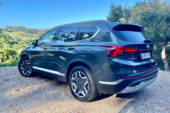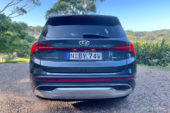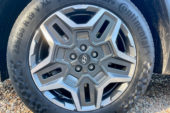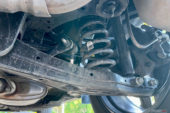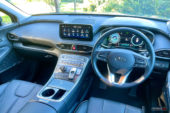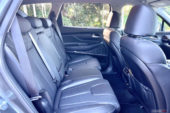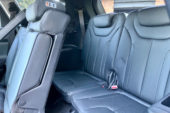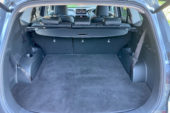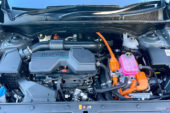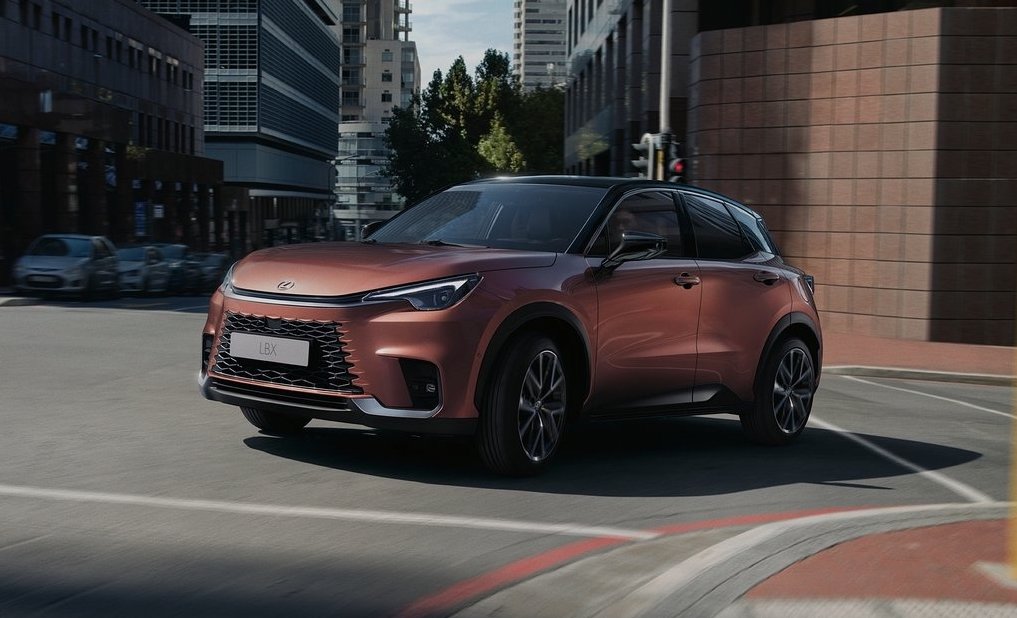While it’s taken some time to get it over the line here in Australia, Hyundai has launched a hybrid variant of its popular seven-seat SUV for 2023 with the Santa Fe.
They say it’s better late than never, but has Hyundai taken so long to get its act together with a large hybrid SUV that its rivals have outpaced it? For now, at least, Hyundai is reserving its hybrid powertrain for its more premium variants, with only the Elite and Highlander offered with the hybrid unit.
The all-new hybrid powertrain does come at a $3000 premium over the equivalent trim level with a diesel engine, too. This begs the question of whether or not the upgrade to Hyundai’s first hybrid-powered Santa Fe is worth it, or if your money is better spent on a more modest variant. Let’s take a closer look at the Santa Fe and see how the potential savings might weigh up over time.
2023 Hyundai Santa Fe Hybrid – THE SPECS
[column width=”47%” padding=”6%”]Engine: 1.6-litre turbo-petrol four-cylinder
Output (combined): 169kW@5500rpm / 350Nm@1000-4500rpm
Transmission: Six-speed auto
Drive type: All-wheel drive
Wheels: F: 19×7.5, 235/55
ANCAP: Not tested
Tare weight: 1940kg
Power-to-weight: 11.47:1 (kg:kW)
Official fuel economy: 6.0L/100km
Economy during test: 6.9L/100km[/column] [column width=”47%” padding=”0″]Fuel capacity/Type: 67L/91 RON
Power efficiency: 24.14kW:L/100km
0-60km/h: 4.09 seconds*
0-100km/h: 8.19 seconds*
60-110km/h: 5.37 seconds*
1/4 mile: 16.15 seconds at 142.6km/h*
Max acceleration: 0.784g*
100-0km/h braking: 2.96 seconds at 37.58 metres*
Max deceleration: -1.155g*
Decibel at idle (on standby): 24*
Peak decibel at 60-100km/h: 78*
Priced from: $63,000[/column][end_columns]
* Figures as tested by PerformanceDrive based on the Highlander variant. Factory claims may be different
2023 Hyundai Santa Fe Hybrid – THE PACKAGE
In terms of its design, the Santa Fe Hybrid is identical to its siblings, with the exception of smaller 19-inch aerodynamic alloy wheels over the standard 20-inch rims. That means the Santa Fe’s distinctive styling package is on show at the front end, while the rear profile remains relatively dull compared with some of the brand’s more modern stuff. All up, it’s a relatively safe bet, albeit with a slightly polarising front grille and headlight design, though the side profile looks slick for a seven-seat package.
As Hyundai is only offering its hybrid powertrain with the mid-level Elite and range-topping Highlander, inside you’ll find a heap of equipment and an upgraded interior design that helps sweeten the deal for the extra money you’ve paid.
Added equipment for the Elite – over the base model and Active – includes a set of LED taillights, power-adjustable and heated front seats, a powered hands-free boot lift, 12.3-inch digital instrument cluster, auto-dimming rear-view mirror, a 10.25-inch infotainment system with digital radio, Apple CarPlay and Android Auto, and an upgraded 10-speaker Harman/Kardon sound system.
It also receives premium touches from the Active variant, including leather upholstery, keyless entry and start, wheel-mounted paddle shifters, a rotary gear selector, dual-zone climate control and a set of front-mounted parking sensors. All up, the amount of equipment and the design of the Santa Fe’s cabin very much matches its price tag.
Up front, the driver and front passenger have a generous amount of space to get comfortable, with the large centre console raising to meet the dashboard that houses a huge number of buttons for the climate, media controls and drive modes.
We’re not massive fans of the button-congested design, though we will say you can acclimatise and it has opened up a huge amount of storage underneath the console for larger hand bags, or bulky drink bottles.
Other practical touches to the front of the Santa Fe’s cabin include a covered storage area housing a cup holder, a deep storage area inside the folding arm rest and a particularly clever smartphone holder that swallows up phones and wirelessly charges them.
The seats feel great, though there are some harder touch points on the door surrounds that your elbows might begin to notice on a long trip. But overall the cabin looks and feels every bit as premium as the price tag would suggest.
Move to the second row of the cabin and there’s a generous amount of both leg and head room available, though the seatbacks themselves are made from a cheap and hard plastic. The second row picks up two USB chargers, air vents and sunshades, and is able to recline back and forth, as well as slide on a set of rails to give those in the third row some extra space if needed.
Third row accessibility isn’t a particular highlight of the design, nor is the headroom on offer. It’s really only suited to young children, putting the Santa Fe into the category of a part-time seven-seat SUV rather than a fully-fledged three-rower in our opinion.
Having said that, the third row isn’t left behind on charging or air vents, with an adjustable fan control, cup holders, storage trays and one USB port on offer.
In terms of boot space, with all three rows standing, cargo space measures in at 130L, expanding to 571L and 1649L respectively as you drop down the seats, making the Santa Fe a beast for ferrying bulky cargo, surf boards and sports equipment.
2023 Hyundai Santa Fe Hybrid – THE DRIVE
While the arrival of the Santa Fe with a hybrid powertrain is a bit of a case of better late than never, the company has come up with a very smooth and fuel-efficient system that manages to catch up with its main rivals in record time.
It comes powered by a 1.6-litre turbocharged four-cylinder petrol producing 132kW/265Nm, which is paired with an electric motor producing an additional 44kW/264Nm, bringing the combined outputs to 169kW of power and 350Nm of torque.
Power is transferred to all four wheels via a six-speed automatic working alongside Hyundai’s all-wheel drive system, providing a very stable, smooth and confident power delivery.
On the road, the electrical assistance gives the Santa Fe some perkiness on the initial push off the line, and a healthy 0-60km/h time as you catch up with traffic, meaning there’s no sacrifices opting for the hybrid over the V6 petrol or turbo-diesel variants.
While the torque curve feels like it flattens out a bit as you pick up speed, the hearty little turbo-petrol kicks into gear with an impressively smooth handover, though it does sound thrashy when you flatten your right foot.
At higher speeds, you’ll find the Santa Fe Hybrid is happy to cruise around on electric power alone, and the petrol unit is more refined when it’s working the background to supply power, rather than doing most of the legwork.
Where the hybrid really begins to stand out is when you’re bumbling around town, maybe running into the shops or picking the kids up from school. At lower speeds, the hybrid system prioritises power from the electric motor, and you’ll often find yourself accelerating from traffic with that instantaneous and silent torque of the electric motor.
This gives the Santa Fe a particularly smooth and relaxing nature around town, and making an already user-friendly SUV package that little bit more refined thanks to the featherweight steering and effortless acceleration off the line.
Of course, the highlight of Hyundai’s new hybrid powertrain is the potential fuel savings, particularly over the 3.5-litre V6 petrol. And the best news is, you don’t have to try particularly hard to return fuel-efficient driving figures.
Our time in the Santa Fe Hybrid saw just under 1000km clocked, with the combined cycle fuel economy figure standing at a very healthy 6.9L per 100km. That compares well against the Santa Fe V6 petrol, which returns 10.5L/100km on the official combined cycle. The official rate for the hybrid is 6.0L/100km.
That’s more than a 50 per cent increase in fuel efficiency, and it pretty clearly illustrates how the fuel savings per tank begin to work away at the premium you’ve paid for stepping up to the hybrid.
Over a week of town and country driving, we can certainly say that the Santa Fe Hybrid is an impressively refined vehicle overall, remaining silky-smooth in the urban environment while soaking up the bumps of a B-road with confidence.
All up, the added torque from the electric motor gives the hefty Santa Fe Hybrid package some impressive motivation off the line, and while it can’t help but show its weight in the corners, the driving experience overall is refined and particularly well suited to a mix of Australia’s rough road conditions.
2023 Hyundai Santa Fe Hybrid – THE VIDEO
2023 Hyundai Santa Fe Hybrid – THE VERDICT
Yes, it is a shame that Hyundai isn’t offering this powertrain in the entry-level Santa Fe right now, the release of the Santa Fe Hybrid marks an important development milestone that will eventually trickle down to its entry-point products.
As a complete package, it’s hard to fault. You get all the space and practicality of Hyundai’s proven Santa Fe interior, with massive fuel savings over the V6 petrol.
We’d argue that buyers are absolutely begging for a base spec hybrid like Toyota has done for a few years now, but for now, this remains your best option for a seven-seat hybrid with a Hyundai badge.
[column width=”47%” padding=”6%”]PROS:
– Fuel-efficient powertrain
– Interior space and practicality
– Comfortable ride quality[/column] [column width=”47%” padding=”0″]CONS:
– Reduced towing capacity over non-hybrid variants
– No entry-level hybrid option
– Busy centre console design[/column][end_columns]
As always, if you’re thinking about buying a new car don’t forget to click here to speak with our car buying specialists.
